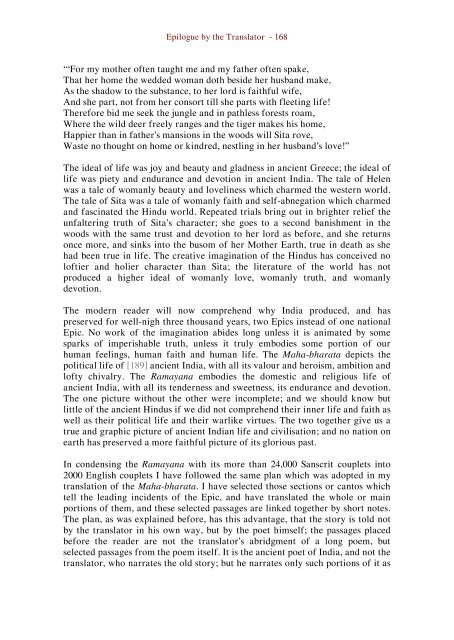Ramayana, Epic of Rama, Prince of India
An Abbreviated Translation of the Indian Classic, the Ramayana by Romesh Chundar Dutt in 2,000 verses
An Abbreviated Translation of the Indian Classic, the Ramayana by Romesh Chundar Dutt in 2,000 verses
You also want an ePaper? Increase the reach of your titles
YUMPU automatically turns print PDFs into web optimized ePapers that Google loves.
Epilogue by the Translator - 168<br />
‘“For my mother <strong>of</strong>ten taught me and my father <strong>of</strong>ten spake,<br />
That her home the wedded woman doth beside her husband make,<br />
As the shadow to the substance, to her lord is faithful wife,<br />
And she part, not from her consort till she parts with fleeting life!<br />
Therefore bid me seek the jungle and in pathless forests roam,<br />
Where the wild deer freely ranges and the tiger makes his home,<br />
Happier than in father’s mansions in the woods will Sita rove,<br />
Waste no thought on home or kindred, nestling in her husband’s love!’’<br />
The ideal <strong>of</strong> life was joy and beauty and gladness in ancient Greece; the ideal <strong>of</strong><br />
life was piety and endurance and devotion in ancient <strong>India</strong>. The tale <strong>of</strong> Helen<br />
was a tale <strong>of</strong> womanly beauty and loveliness which charmed the western world.<br />
The tale <strong>of</strong> Sita was a tale <strong>of</strong> womanly faith and self-abnegation which charmed<br />
and fascinated the Hindu world. Repeated trials bring out in brighter relief the<br />
unfaltering truth <strong>of</strong> Sita’s character; she goes to a second banishment in the<br />
woods with the same trust and devotion to her lord as before, and she returns<br />
once more, and sinks into the busom <strong>of</strong> her Mother Earth, true in death as she<br />
had been true in life. The creative imagination <strong>of</strong> the Hindus has conceived no<br />
l<strong>of</strong>tier and holier character than Sita; the literature <strong>of</strong> the world has not<br />
produced a higher ideal <strong>of</strong> womanly love, womanly truth, and womanly<br />
devotion.<br />
The modern reader will now comprehend why <strong>India</strong> produced, and has<br />
preserved for well-nigh three thousand years, two <strong>Epic</strong>s instead <strong>of</strong> one national<br />
<strong>Epic</strong>. No work <strong>of</strong> the imagination abides long unless it is animated by some<br />
sparks <strong>of</strong> imperishable truth, unless it truly embodies some portion <strong>of</strong> our<br />
human feelings, human faith and human life. The Maha-bharata depicts the<br />
political life <strong>of</strong> [189] ancient <strong>India</strong>, with all its valour and heroism, ambition and<br />
l<strong>of</strong>ty chivalry. The <strong><strong>Rama</strong>yana</strong> embodies the domestic and religious life <strong>of</strong><br />
ancient <strong>India</strong>, with all its tenderness and sweetness, its endurance and devotion.<br />
The one picture without the other were incomplete; and we should know but<br />
little <strong>of</strong> the ancient Hindus if we did not comprehend their inner life and faith as<br />
well as their political life and their warlike virtues. The two together give us a<br />
true and graphic picture <strong>of</strong> ancient <strong>India</strong>n life and civilisation; and no nation on<br />
earth has preserved a more faithful picture <strong>of</strong> its glorious past.<br />
In condensing the <strong><strong>Rama</strong>yana</strong> with its more than 24,000 Sanscrit couplets into<br />
2000 English couplets I have followed the same plan which was adopted in my<br />
translation <strong>of</strong> the Maha-bharata. I have selected those sections or cantos which<br />
tell the leading incidents <strong>of</strong> the <strong>Epic</strong>, and have translated the whole or main<br />
portions <strong>of</strong> them, and these selected passages are linked together by short notes.<br />
The plan, as was explained before, has this advantage, that the story is told not<br />
by the translator in his own way, but by the poet himself; the passages placed<br />
before the reader are not the translator’s abridgment <strong>of</strong> a long poem, but<br />
selected passages from the poem itself. It is the ancient poet <strong>of</strong> <strong>India</strong>, and not the<br />
translator, who narrates the old story; but he narrates only such portions <strong>of</strong> it as

















